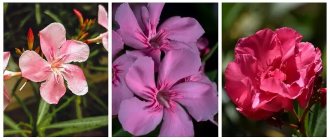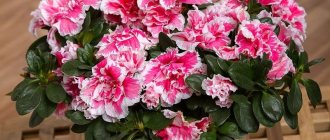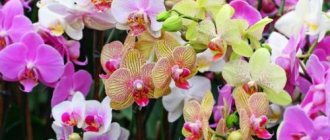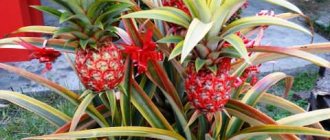When Publius Virgil, an outstanding ancient Roman poet, described the beautiful shepherdess Amaryllis in one of his works, he certainly did not suspect that centuries would pass and another famous person, the botanist Carl Linnaeus, would name one of the flowers by the name “amaryllis” - sparkling. But that’s exactly what happened, and now amaryllis is a fairly popular indoor plant. When it blooms, there is no question as to why it was called “sparkling.” The beauty of the plant is obvious.
Amaryllis: botanical description and appearance
Amaryllis is one of the genera of the Amaryllis family. Linnaeus identified this genus in 1753, although the flower was known to Europeans earlier, under the name lionnarcissus.
But the greatest taxonomist made a serious mistake when he classified hippeastrums, similar flowers, also from this family, as amaryllis. This went on for many years, until the hippeastrums were separated into a special genus. But even now, many flower lovers confuse these two completely different species. However, they have a good excuse, because Linnaeus himself confused the plants!
And distinguishing them, in fact, is not so difficult. There are several sure signs, let’s name just three:
- The amaryllis peduncle is filled inside with soft tissue, while in hippeastrums it is hollow;
- Amaryllis flowers have a pronounced smell, while hippeastrum flowers have no smell, or smell very weakly;
- On the peduncle of amaryllis there are from 8 to 12 flowers, in hippeastrum there are no more than 6, and they are larger.
But let's return to our hero! He is originally from the Cape region of Africa. Many people believe that Africa is a very warm, even hot, continent. And this is generally true. But there are areas here where the climate is not so warm. One of them is the extreme southwest of the continent, where the waters of the Indian and Atlantic oceans meet. The narrow coastal strip has a climate similar to the Mediterranean: with cool winters and alternating dry and hot seasons. Here is the homeland of many endemic plants, including amaryllis.
Amaryllis is a typical perennial bulbous plant. It has narrow, several centimeters, but long leaves, growing from a pear-shaped bulb, with a diameter of 8 to 12 cm. It produces a long, strong peduncle, sometimes two at once. On the peduncle there is an inflorescence of funnel-shaped flowers, from 6 to 12, each with a diameter of 4 to 8 cm. The flowers are six-petaled, with a characteristic pointed tip. As already noted, they have a pleasant, fragrant smell, and a wide variety of colors.
As the amaryllis fades, it loses both its leaves and peduncle, gradually going into a dormant state. At this time, the Cape Region is cool and dry, and this feature should be taken into account when growing home amaryllis flowers.
Breeding
Let's look at this in more detail. There are no problems with amaryllis propagation. According to experienced flower growers, this can be done in the following ways:
- Seminal. To obtain high-quality planting material, you need to use a brush to transfer pollen from the stamen to the pistil of various plants. After about 30 days, the seeds will be fully ripe and ready for sowing. They need to be planted immediately after collection, since over time their properties and quality decrease, as a result of which the percentage of germination drops significantly. The best substrate for planting is composed of humus and leaf soil mixed in a ratio of 1 to 2. The seeds are deepened 5 millimeters into the soil and moistened with a spray bottle. Next, the flower pots are placed in a room in which a constant air temperature is maintained ranging from 20 to 24 degrees Celsius. After the first shoots appear, the plants can be replanted.
- Vegetative propagation. Amaryllis babies are separated from the mother bush and planted in the ground until they germinate. As soon as they send out shoots, they are planted in pots.
- Dividing the bulb. The upper part is cut off along with the stem, after which the remaining part of the body is divided into four equal parts, which are separated from each other by knitting needles. Containers with bulbs should be kept at a temperature of 24-28 degrees under good lighting, keeping the soil constantly moist. After about a year, the flowers can be replanted.
Popular articles Agapanthus: planting and care in open ground
According to many experts, the most effective way to propagate amaryllis is vegetatively or by dividing the bulb. Seed is quite problematic and does not always allow you to get the desired result.
Amaryllis varieties
Until recently, it was believed that amaryllis were represented by only one species. But recent changes in taxonomy have led to the identification of four species within the genus. However, only one of them is used for home maintenance - Amaryllis belladonna.
Finding a real “belladonna” is a great success for an amateur florist! The thing is that only bulbs of varieties created by people go to markets and stores. Moreover, many of these varieties are hybrids of amaryllis and hippeastrum (still, fate does not separate these plants!). Breeders strive to:
- develop varieties with double and simple flowers;
- create hybrids with unusual flower shapes: with narrow and corrugated petals (spiders), with petals with a forked end, etc.;
- find more and more new color options;
- obtain hybrids with extra-large, or, conversely, unusually small flowers.
Along with new varieties, old, classic varieties are also valued among connoisseurs: Hathor; Durbar; Parker.
Tricks of care after flowering
Immediately after the hippeastrum fades, it is prepared for a period of rest. The quality of flowering next time directly depends on this. As soon as the flower withers, stop watering. The pot with the plant is moved to a cool, dark place. The leaves and peduncle are not touched, they are allowed to die. What is it for? So that the nutrients in the peduncle return to the bulb. If you cut off the arrow before it dries out, we will deprive the root of this opportunity. Therefore, after the leaves die, they cut off the wilted flowers and wait for the arrows to dry. This will be easy to remove from the bulb. Hippeastrum's vacation will last two to three months. It is not necessary to moisten the soil. Next, according to the familiar scheme, is the withdrawal from the resting state. That is, we put the pot on the window and wait for the arrow to go out. After waiting for the sprout to reach 10 cm, watering begins with fertilizer along the edge or into the pan.
Conditions required for amaryllis, plant care
In general, the plant can be safely classified as unpretentious. When deciding how to care for amaryllis at home, you just need to keep in mind that the plant has periods of dormancy and growing season, and during these periods it will require different approaches from the owner.
Lighting and location
During the active growing season, you need to provide bright but diffused light, especially during flowering. Southern, eastern, and western windows will suit him if they are slightly shaded during sunny hours. During the rest period, the pot can be completely hidden in the closet; the bulb does not need light.
Air humidity
The one we are used to living in will do. Amaryllis will not require additional moisture. On the contrary, too high humidity can lead to fungal diseases.
Ambient temperature
During the growing season, the ideal temperature will be from +18°C to +26ºC. With the “cool” option, the flowers last longer. A bulb that is on rest can be placed in cooler conditions, but not lower than +12ºС.
Watering and fertilizing
Caring for amaryllis at home involves regular and abundant watering. At the same time, it is very important that water does not accumulate in the pot and quickly drain through the drainage layer. The rule works here: it’s better not to top up than to overfill. Thanks to the moisture reserves in the bulb, the amaryllis will not die, even if it is overdried. At the same time, even a one-time flood with stagnant water can provoke fungal diseases.
Important! When watering amaryllis, you need to make sure that water does not fall on the bulb, and even more so, does not stagnate at the growing point.
Water with water that is no colder than the ambient temperature.
Attention! Amaryllis need to be watered after a rest period only when the peduncle reaches 10 cm in length. If you start doing this earlier, the flower will slow down its preparation for flowering and will begin to grow leaves intensively.
When watering, use fertilizer. You can add any mineral mixtures for flowering plants. Sets with a high content of phosphorus and potassium are preferable. Liquid fertilizers are very convenient, not only mineral, but also organic. Feed amaryllis three times a month, and more often during budding.
Flowering plant
The dormant period can last until the end of May . After this, the bulbs lay flower buds. The plant blooms in late summer - early autumn. The plant grows an elongated peduncle.
It can reach more than 85 cm in length. At the top there is an inflorescence on which flowers are formed. If there are too many of them, they are arranged in two tiers. The inflorescence is in the form of an umbrella, the flowers are in the form of a funnel. They have 6 petals. They reach 7-11 cm in diameter. The pistil is elegant, thread-like. Stamens in the amount of 6 pieces.
Photo
You can clearly see how beautiful amaryllis blooms in the photo below:
Period
Amaryllis is a bulbous flower. After planting, it begins to actively grow and throw out flower stalks. After 1.5-2 months, 1-2 powerful peduncles appear on the bulbs. Each of them will have 5-7 magnificent flowers . To extend the flowering period, keep the container in cold rooms without direct sunlight.
IMPORTANT! When 3 flower shoots appear, it must be immediately cut off at the root system.
Triple flowering of this representative of the flora greatly deteriorates the bulb and leaves it almost without the necessary microelements. After the first flower begins to bloom, it is recommended to cut off the peduncle immediately.
It is placed in boiled water. The water in the dishes is changed daily. The flowering period for cutting and flowering is identical. But by removing the peduncle, professional gardeners reduce or prevent the depletion of the bulb. Also, proper removal stimulates the growth of a new grower. After flowering, this representative of the flora must be provided with a period of rest .
Planting and transplanting
Planting amaryllis begins with the selection of bulbs. It doesn’t matter if they are bought in a store, or if you use your own, dug up during the holidays. The following operations need to be performed:
- inspect the bulb, check for damage, dents, signs of rot or fungal diseases. An excellent sign is strong, light roots;
- remove dead, gray or black, dry scales from the bulb. Reach the light, or slightly greenish, body of the bulb;
- soak the bulb in pink potassium permanganate, or a solution of any available herbicide;
- inspect again, suspicious areas can even be carefully cut off. Treat with “phytosporin” or brilliant green;
- Place the onion on a newspaper or cloth and dry for about a day. That's it, the amaryllis bulb can be planted in a pot!
Selection of pot
It should be only 3-4 cm larger in diameter than the bulb itself. In a large container, amaryllis will “produce” children, but not bloom. You can understand the “logic” of a flower: why does it reproduce by seeds if it can do this by producing daughter bulbs?
At the same time, it is necessary to select a heavy pot, because a well-developed amaryllis, and even one with a large, tall peduncle, can easily tip over. In addition, when caring for amaryllis at home, do not forget to take into account its powerful root system. It is clear that in a cramped pot the roots will tend downwards. It is best for the pot to be slightly pear-shaped: wide at the bottom, tapering at the top.
Land selection
Many earthen mixtures sold in stores are suitable for amaryllis. The main thing is that they are light and moisture-resistant. If you want to prepare the soil yourself, use the following diagram as a guide:
- turf soil - 1 part;
- deciduous soil - 2 parts;
- matured humus - 1 part;
- peat - 0.5 parts;
- coarse sand - 0.5 parts.
And, as is customary for bulbous plants, do not forget about organizing a good drainage layer!
Direct landing
Having filled the pot halfway with soil, compact it slightly and plant the bulb, straightening the roots along the ground. Add soil so that about a third of the bulb is visible from above. Lightly compact the soil again and water it with warm water, but not too much.
Transplanting amaryllis
It is carried out either after flowering or in the spring. Young plants are replanted annually, adult, flowering ones - once every 3 years. But every spring it is useful to replace the top layer of soil with a new, more nutritious one. Amaryllis transplantation at home is also carried out when there is a suspicion of a fungal disease of the bulb. In this case, when replacing the soil, you need to treat the walls of the pot with boiling water.
What to do if something goes wrong - tips and warnings
Sometimes, even with good care, amaryllis refuses to bloom. There may be several reasons in this case:
- the pot is too wide, allowing the plant to spend all its energy on growing “babies” rather than flowering;
- lack of nutrients in the soil;
- poor lighting and unsuitable temperature conditions during the growing season;
- lack of a rest phase;
- infection by fungi and parasites.
The following problems may arise during cultivation:
- Wilting and pale or yellowing of leaves, blackening of flowers . This can happen to flowers placed in extremely damp and cold areas. The solution to the problem will be the normalization of temperature and watering conditions.
- Slow growth against the backdrop of falling leaves . Such symptoms appear during an amaryllis bug infection. To get rid of aphids, it is recommended to wipe the leaves with a solution of potassium soap.
- Light markings on leaves and stems. Sign of a mealybug. Eliminated by wet wiping the leaves and spraying with insecticides.
- Brown spots on leaves. They are caused by a pest - the false scale insect. To heal the plant, you need to prepare a solution of laundry soap and wipe the affected areas with it.
- Bulb rotting. Indicates the presence of a narcissus fly or onion mite. Preventive measures are required before planting, namely disinfection of the soil, bulb, and pot.
If the bulb rots, you can try to revive it as follows:
- Remove damaged areas with a knife.
- Lubricate the cut areas with an antiseptic.
- Dry.
- Process in Maxim.
- Place in a dark place for two days.
- Immediately before planting, remove dried parts.
Even an inexperienced beginner can handle caring for amaryllis. It is enough just to provide it with optimal conditions in accordance with the characteristics of growth and development, as well as to have a small amount of knowledge about planting and replanting the plant. It would be useful to familiarize yourself with the main diseases to which the flower is susceptible and methods of treating them. About diseases, pests and treatment of amaryllis is written here.
You may be interested in our articles about the amaryllis belladonna variety and about other varieties of the plant, as well as publications about caring for the plant in winter. Also read about the differences between amaryllis and hippeastrum.
"Two Lives of Amaryllis"
So, the amaryllis flower at home has two completely different periods of development.
Flowering period
It begins immediately after winter, in early spring. At this time, the rested bulb releases a peduncle. It has already been said that the soil does not even need to be watered at this time, maintaining only a minimum level of humidity. Amaryllis blooms without leaves, and this is what makes it unusual. Leaves begin to appear only during flowering.
If there are several peduncles, and this happens with strong bulbs, the excess ones are removed, leaving no more than two. If this is not done, the bulb will become depleted, and the flowering will not be good.
Interesting! As soon as the first flower in the inflorescence opens, the peduncle can be cut off and placed in water. The flowers will gradually open, just as they would on a plant. But in this case, the bulb will not be so depleted.
It should also be noted that amaryllis can bloom again this year, but for this the bulb needs to rest for at least two months.
Attention! Try to bring amaryllis out of dormancy early, by the beginning of spring, or even in February. Firstly, at this time there are few flowering plants, and secondly, you can find a cooler place for it. After all, the colder the air is (naturally, within the limits that we indicated earlier), the longer the flowering will last.
Rest period
As a rule, by the end of flowering (and it lasts about three weeks), the amaryllis already acquires leaves. The peduncle dries out; the vegetating bulb must continue to be cared for. Gradually its leaves will begin to turn yellow and dry out. This is how amaryllis prepares “for bed” in its homeland, in the Cape Region.
Don't bother him either. Just don’t cut off the unsightly leaves in advance; let them die off naturally. As they dry out, they gradually release the accumulated nutrients to the bulb. At this time, watering is gradually reduced, and fertilizing is completed even earlier. There comes a moment when the bulb no longer has either a peduncle or leaves; it is in a semi-dry substrate. This is a period of rest. Ideally, it should last about three months.
During these months, the bulb should be kept in a cool, dry place, such as a basement. The refrigerator is not suitable because the temperature is too low. Many gardeners prefer to dig up the bulb altogether and wrap it in paper and store it in a closet.
As soon as you decide that it is time to “wake up”, take the amaryllis into a warm place, plant the bulb if it has been dug up, and wait patiently. Don’t be afraid of the dry substrate - the peduncle will begin to grow, feeding on the substances accumulated in the bulb.
Knowing the cycle of amaryllis, it is not difficult to guess that its forcing can be “adjusted” to any event, at any time of the year, as is done, for example, with hyacinths. The main thing is that the bulb goes through a rest period.
How to care for a cut flower?
It is recommended to cut the flower when the buds are opening. In order for a cut plant to retain its beauty for a long time, it is necessary:
- Trim the stem evenly.
- Lower its end for a quarter of an hour in water with a temperature of at least 45-50 degrees.
- Pierce the hollow stem to allow air to escape at the top.
- And seal its bottom with a piece of cotton wool.
- Place the flower in a vase with water.
- Ensure optimal temperature conditions above 7 degrees Celsius.
When cut, amaryllis flowers can be stored for no more than a week.
You can learn about amaryllis bouquets here.
Reproduction methods
Actually, there are three of them:
- children, or daughter bulbs;
- dividing the bulb;
- seeds.
The first method ( by children ) is the most common, convenient and easy. As a rule, by the end of the growing season, small children appear near the adult bulb. In the spring, when transplantation takes place, the children are separated from the mother bulb and planted in separate pots. Subsequently, they are cared for without providing a rest period, regularly increasing the pot. Two years pass in this way, and in the spring of the third, the mature bulb, as a rule, blooms.
Seed propagation is used less frequently, mainly because in this case you have to wait two years longer for flowering. Most often, the method is used to obtain new varieties and hybrids. But the method itself is simple, the seeds germinate smoothly and without problems.
It also happens that when caring for an amaryllis flower at home, you have to propagate it by dividing the bulb . This usually happens if the bulb is rare, there is only one, and for some reason it needs to be propagated without waiting for the children to appear. This method is risky and requires courage and acquired skills.
The essence of the method is that the onion is carefully cut into several parts. A prerequisite is to preserve a piece of the bottom and at least one scale on each part. The sections are treated with crushed coal and planted in almost dry but warm sand (at least +25ºС).
After about a month, under favorable conditions, the first leaf appears, followed by the second. At this stage, the sprouted parts of the bulb are planted in the soil, in their own separate pots.
Solving Common Problems
Diseases, pests and violations of maintenance conditions have a negative impact on the appearance of amaryllis, slow down the growing season, and often prevent flowering. Let's look at possible problems and solutions.
Care errors
If the conditions of maintenance are violated, the amaryllis looks faded and unkempt, the foliage withers, the peduncle grows slowly, with a small number of weakened buds.
The leaves are turning pale
Leaf lightening is caused by excess light. The plant is removed from the sun and slightly shaded.
Blackening of flowers
Cold, excessively humid air leads to darkening of flowers. To solve the problem, reduce watering and raise the air temperature in the room above 18-20 °.
Slow growth
Slow development is caused by a lack of light, moisture, fertilizing, and damage by diseases and pests. Normalization of care and treatment is required depending on the problem.
White spots
When infested with mealybugs, white spots appear on the green part. Treatment is insecticides.
Bulb rotting
Bulbs rot due to excess moisture, pest damage and fungal diseases. The solution is normalization of watering, treatment with insecticides and fungicides.
Brown spots
Yellow-brown spots are traces of the impact of the false scale insect. Amaryllis is treated with insecticides and folk remedies.
Yellowness of leaves
Excess moisture and aphid infestation can cause yellowing of the foliage. Watering is reduced and the pest is controlled.
Diseases
Most diseases are caused by infection of bulbs and soil by fungi. Excessive watering provokes the development of amaryllis diseases.
Anthracnose
Signs: brown dry streaks at the ends of the leaves. Treatment – soil replacement, fungicides.
Stagonosporosis
Signs of red rot are stripes and spots on the bulb, then on the foliage, orange-red in color. Treatment - bulb extraction, pruning, treatment with fungicides.
Gray rot
Signs are grayish spots on the foliage. Treatment is treatment with fungicides.
Important: if the amaryllis bulb is severely damaged, it is better to destroy it - this will prevent infection of other plants.
Root rot
Signs: deformation, spots on the bulb, wilting of the green part. Treatment - pruning to healthy tissue, treatment with fungicides.
Fusarium
The scientific name for root rot. The disease is caused by fungi of the genus Fusarium.
Pests
Bulb pests are especially dangerous for amaryllis. The infection remains undetected for a long time, during which time the damage often becomes irreversible.
The plant has to be destroyed so that neighboring crops do not become infected.
Onion mite
The pest eats the bulbs. It is usually discovered when the green part begins to fade. It is difficult to fight the mite; the plant usually dies.
See also
What to do and how to fight if there are midges in the orchid
False shield
Brown seals and spots on the foliage are traces of the false scale insect. Treating with a soap solution, Actellik, Aktara will help you cope with the pest.
Aphid
Weakened, yellowed leaves are a consequence of aphid infestation. Pests are removed manually using insecticides or folk remedies.
Mealybug
A white cottony coating on greens is a sign of mealybug infestation. The foliage becomes sticky and deformed. Physical removal and insecticides help.
Thrips
Stripes, spots, and holes on the foliage are left on amaryllis by thrips. This is a common type of pest that is combated by double application of insecticides - Actellica, Karate, Intavira.
Spider mite
When air humidity is low, spider mites quickly multiply on amaryllis, which can be seen by the thin mesh under the leaves. Treatment – insecticides, increasing air humidity.
Amaryllis mealybug
The white pest hides in onion scales, eating tissue. It is necessary to remove the bulb, excise the damage, and treat it with medications.
springtail
The white insect can be found on the soil. Destruction will require replacing the top layer of soil, treating with insecticides, and limiting watering.
Problems during cultivation
There may be many of them, but the most painful one is why amaryllis does not bloom at home? Sometimes it is difficult to name one reason; there may be several of them at once, but here are at least the five most common ones.
- There was no full period of rest. The bulb has “lost” its reserves of organic substances.
- The pot is too big. Children are formed to the detriment of flowering.
- Lack of light, heat, or both.
- The root system is damaged, the roots are small and are unable to ensure flowering.
- The bulb did not receive adequate nutrition throughout the season.
What kind of flower is this, what are the characteristics of its growth?
Amaryllis is a South African flower that is highly decorative, not too picky in care and maintenance, and has several features associated with its natural growing environment. You can find out what amaryllis looks like and what its structure is here. When cultivating a plant, the following factors must be taken into account:
- Sufficient amount of light . Amaryllis requires bright lighting, however, direct sunlight should be avoided.
- Optimal watering . Amaryllis naturally grows in tropical and subtropical climates. Therefore, it is advisable to maintain indoor humidity above 50%, as well as occasionally spray the leaves with a spray bottle in the summer.
- Correct temperature conditions . During the growing season, the temperature in the room should not fall below 18 degrees, and during hibernation the optimal temperature is 15 degrees.
- Well-chosen container for planting . For amaryllis, a deep bowl of small diameter (up to 15 cm) with good drainage is suitable. Too large a container can lead to the development of “babies” and lack of flowering. You can find out why amaryllis doesn't bloom and how to make it produce buds here.
Features of growth in the cold season
Amaryllis is a fairly unpretentious bulbous plant, usually blooming in spring . First, the flower produces several peduncles with a large flower in turn. And then it begins to grow large leaves. After some time, the foliage becomes pale and withers. This means that a period of rest begins.
What happens to the plant?
From mid-September until spring, amaryllis begins a dormant period, when the plant regains its strength after a period of active growing season. By this time, flowering and growth have stopped, and the flower, having shed its powerful foliage, begins preparing for dormancy.
How to grow amaryllis so that it blooms at the desired time
To force amaryllis to bloom at a certain time, it needs to be provided with a period of rest. Approximately 6 weeks before the desired date, for example, for the holiday of March 8 or for the birthday of a loved one, they begin to water the plant with warm water, bringing it out of the dormant state and wait for flowering at the desired time.
Blooming amaryllis
A houseplant with a pleasant aroma of flowers will be a good option for a living bouquet or as an independent gift. The main thing is to choose a healthy specimen and provide it with decent care.
Care errors
If you take care of the plant, it will have a bright and attractive appearance. But there are common mistakes that can be avoided:
- If the flowers are very pale, it means that the pot is exposed to direct sunlight. We need to find a darker place.
- In a damp and cold room, the opposite reaction occurs: the flowers darken, and sometimes can even turn black.
- Insufficient watering causes the flowers to droop and the leaves to become pale.
- When damaged by thrips or other pests, the leaves turn yellow.
Bulbous plants are distinguished by gorgeous flowering. But if their care is not entirely good, the plant becomes capricious and does not bloom.
Reasons for this condition:
- There was no dormant period for the bulb.
- There wasn't enough sunlight.
- Low room temperature.
- The soil is not fertilized enough.
- The bulb is damaged by pests.
If there are small children in the house, you need to remember that amaryllis is not only an exquisite flower, but also a poisonous plant. Its bulbs contain poison that African natives used in arrows. A tip soaked in such juice could lead to the death of a person. Small doses of poison are, of course, not lethal, but as a precaution when transplanting and working with the bulb, it is better to use gloves and not allow children to participate in this process.
Amaryllis Aphrodite will decorate any interior
Recently, interest in tropical plants has increased. After all, they give the interior of the house originality and special sophistication. Amaryllis can be considered just such a representative of the flora. How to care for it so that it blooms and no one remains indifferent to the bright buds - the main thing is that everything must be done with love, and the result will not be long in coming.
Propagation by seeds: all the subtleties of the process
Growing a new plant with seeds is much more difficult than with daughter bulbs. But such flowers can live up to 20 years or more.
In order for the plant to reproduce by seeds, artificial insemination is performed. A brush collects pollen from the stamens of one flower and transfers it to the stigma of another. In a month, seeds will appear, which must be immediately planted in well-moistened soil. After this, the containers with the crops are removed to a warm, dark place. The first shoots are observed after 3 weeks. With the appearance of the first three leaves, the seedlings need to be transplanted into a separate container.
For your information! Flowering will occur 7 years after planting the seeds.
Amaryllis seeds
What difficulties are possible?
The owner himself does not always notice that the conditions important for growing the crop have changed. The temperature regime cannot exceed 24 degrees. But even during the flowering period it should not fall below 19 degrees. Without such conditions, amaryllis may weaken and drop its buds.
And one more point: during the watering period, some gardeners do it incompletely, as a result of which the top layer of soil may remain dry. Be sure to spray the flower with warm water from a spray bottle.
Amaryllis is a beautiful plant; during the flowering period it has no equal. It looks perfect in a gift bouquet, or simply as an interior decoration. Therefore, careful care and some capriciousness are a tribute equivalent to luxurious flowering. When purchasing amaryllis, be prepared to study information about it - the flower will not survive if the grower is not “armed” with knowledge.
You can watch the video below about planting amaryllis.
Amaryllis at rest
The dormant period should last 3-4 months so that the plant gains strength for a new full flowering, otherwise it can quickly become exhausted and die. During this period, amaryllis needs to be properly cared for. It requires diffused light. There is no need to trim the leaves so that the organic matter from them passes into the bulb.
Amaryllis bulbs
During rest, the bulb can be removed from the pot, the “babies” separated and the mother plant replanted.
What to do with the onion
Typically, gardeners leave amaryllis in a pot after flowering for a dormant period. However, according to the rules, the bulb must be pulled out of the ground, the roots must be cleaned, and the dried elements must be cut off.
To protect planting material from diseases, the bulbs are placed in a weak solution of potassium permanganate, dried, wrapped in a dry cloth and stored. A preventive examination should be performed every 2 weeks.
Important! The planting bulbs are quite large in size.











